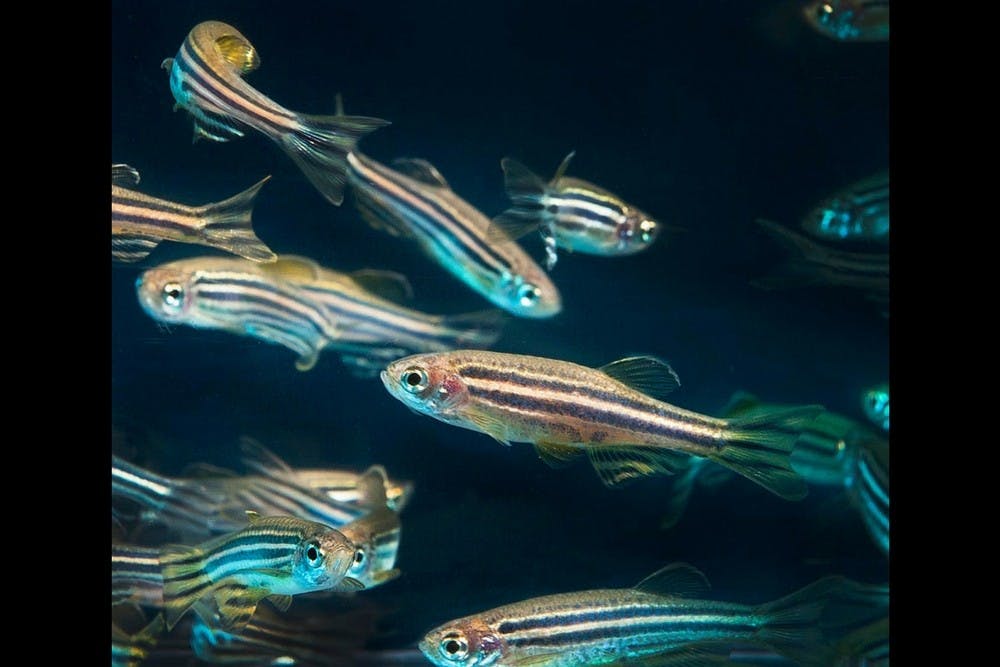Zebrafish, a model organism already renowned for its regenerative abilities, has shown promise in yet another area of the field—spinal regeneration.
Duke researchers discovered that when massive cushioning cells in the zebrafish notochord—a precursor to the spine in vertebrates—are damaged, another type of cell can find and replace the damaged ones. Because these cushioning—or vacuolated—cells are similar between fish and humans, the discovery could yield clues with the potential to help victims of back or neck pain.
“We saw that a cell type surrounding the giant cells moved in to the region of disruption and [was] actually able to replace the giant cells that had been compromised, restoring the notochord structure,” wrote Jamie Garcia, graduate student in the School of Medicine and co-first author of the paper.
Michel Bagnat, senior author of the paper and associate professor of cell biology, likened the notochord to a tube. The outside of the notochord, or casing of the tube, is composed of sheath cells, while the interior houses immense, egg-shaped vacuolated cells. These vacuolated cells account for the notochord’s ability to cushion and stretch.
However, Bagnat explained, the initial purpose of the research was not to identify a spinal repair mechanism, but rather to explain how the notochord can withstand such heavy mechanical stress.
“What you have is a very large cell, which is presumably fragile, that is subject to a lot of stress,” he said. “And then we ask, ‘How is it keeping together?’”
They first concentrated on caveolae—minuscule pockets of the cell membrane—as one possible explanation for the notochord's durability, and discovered that vacuolated cells lacking caveolae collapsed under heavy stress, ceasing to function properly.
“We made mutants to basically disrupt [caveolae], and we were expecting that there would be some sort of disruption in these cells, which we found,” Bagnat said.
The role of caveolae in the notochord matched the original hypothesis, but the research took an unexpected turn when the mutant zebrafish lacking proper caveolae ended up developing a fully formed spine. Bagnat explained that this was because the surrounding sheath cells differentiated—or transformed—into vacuolated cells. Somehow, the released contents of the damaged cell induced nearby sheath cells to replace the damaged structure.
The study is relevant to spinal degeneration in humans, as humans also possess vacuolated cells as shock-absorbing intervertebral discs. These discs can degenerate or become herniated, causing neck or back pain. However, according to the Mayfield Brain and Spine Clinic, nearly 30 percent of people without such pain also have some form of degeneration in intervertebral discs.
“The disappearance of the giant vacuolated cells (which are conserved from fish to human) is often associated with degenerative disc disease,” Garcia wrote. “If we can understand how this basic regeneration process works in fish, we can better understand and possibly implement disc regeneration in humans who experience this condition.”
Bagnat noted that a spinal repair mechanism is likely to exist in humans, but whether the process is the same as in zebrafish is unknown at this point.
“If there was no repair mechanism, we would probably lose these vacuolated cells out of the center of the intervertebral disc very rapidly,” Bagnat said. “[However], in fact, we keep them for quite a long time.”
Both Bagnat and Garcia explained that one of the lab’s interests is understanding how the sheath cells receive the necessary instructions to differentiate into a vacuolated cell. Bagnat suspected that the answer may lie in the contents released by a damaged vacuolated cell, so studying this fluid could answer some major questions concerning disc repair.
“If you understand the biology, perhaps you can keep the disc in better shape for a longer time,” he said.
Get The Chronicle straight to your inbox
Signup for our weekly newsletter. Cancel at any time.

